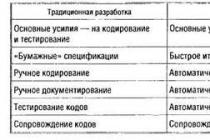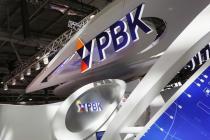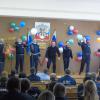SMALL EDGE CUTTER "CHIBIS" PROJECT 21850
14.09.2013
On September 9, 2013, another boat of project 21850 Chibis was launched at the Vympel Shipbuilding Plant OJSC. Upon completion of the factory sea trials, the boat will be sent to the base. Small border boats "Chibis" of project 21850 develop a speed of over 37 knots and can ensure the implementation of a wide range of tasks facing law enforcement agencies.
12.05.2014
On April 22 and 24, 2014, two small border boats "Chibis" of project 21850 were launched at the Vympel Shipbuilding Plant JSC. These are the first boats from the series built for the FSB of Russia this year. After passing the mooring, factory running and acceptance tests, the boats will be delivered by rail to the place of deployment.
28.05.2014
On May 27, 2014, a small border boat of project 21850 "Chibis" was launched. This is the third boat in the series, built for the FSB of Russia this year. The first two boats this project have already passed mooring and factory sea trials and are prepared for shipment by rail to the place of basing.
02.07.2014
On June 27, 2014, a small border boat of project 21850 "Chibis" was launched. This is the fifth boat in the series, built for the FSB of Russia this year.
Also today, an acceptance certificate was signed for the Chibis, launched earlier, which has already passed all the tests.

01.06.2015
Small border boats of project 21850 "Chibis" (serial numbers 02121, 02122, 02123), launched in May, are undergoing factory sea trials in the Volga waters near Rybinsk.
On June 3, a commission of the Border Guard Service of the Federal Security Service of Russia will arrive at JSC Shipyard Vympel to conduct acceptance tests of boats. Crews of boats will arrive a little earlier for acceptance and training. Then the boats will go by rail to their permanent base - to the Crimea.
This year, the Vympel shipbuilding plant will have to hand over 12 Chibis boats, the last of which will go to the duty station in October. www.vympel-rybinsk.ru
SHIPBUILDING PLANT "VIMPEL"
19.06.2015
On June 17, the State Commission signed acceptance certificates for sea tug coastal navigation project 1496M1 "Manatee" (serial number 01407) and three small border boats of project 21850 "Chibis" (serial numbers 02121, 02122, 02123).
During the acceptance tests, all declared tactical and specifications boats, such as seaworthiness, speed, maneuverability. Members of the commission checked radio communications, navigation, weapons, habitability. The acceptance certificates were signed without remarks.
Now the boats will head to their place of duty in the home port of Balaklava. The lapwings will be delivered by rail, the Manatee will go to the place, accompanied by a tugboat.
20.08.2015
On August 18, 2015, another small border boat "Chibis" was launched at JSC "Vympel Shipbuilding Plant" production program this year. Its serial number is 02128. On August 4, the Chibis with serial number 02127 was launched, now it is undergoing mooring tests, and from August 24 it will start running. The boat with serial number 02126 is already on sea trials, it will have acceptance tests.
The descent of the Chibis into the water was observed by teams of three boats that arrived on the Vympel. Boats with serial numbers 02126, 02127, 02128 will serve in the FSB of Russia in the Republic of Kalmykia and the Astrakhan region. Acceptance certificates must be signed on September 1.
Project 21850 boats with serial numbers 02124 (launched on June 24), 02125 (launched on June 30) were sent by rail to Rostov-on-Don to the Border Directorate of the Federal Security Service of Russia for the Rostov Region. Boats manufactured at the Vympel shipyard are now shipped via railway in a special packaging of shrink film. It ensures maximum safety of ships during transportation and storage.
OJSC "Shipbuilding plant" VYMPEL "

20.09.2015
On September 16, a small border boat "Chibis" serial number 02130 was launched at the Vympel Shipbuilding Plant JSC. This is the tenth project 21850 boat of the current year's production program. In two days, he will enter the factory sea trials.
The boat "Chibis" with serial number 02129, launched on September 3, has already passed the factory running, is now on acceptance tests. At the beginning of next week, the State Commission plans to sign the acceptance certificate. After that, the boat will go to the place of service in the city of Baltiysk, Kaliningrad region.
07.10.2015
On October 2, 2015, Vympel Shipbuilding Plant JSC (Rybinsk, Yaroslavl Region) launched a small border boat of project 21850 "Chibis" with serial number 02131. This was reported by the plant's press service. October. After the acceptance tests, which are scheduled for October 12, the boat will go to the border department of the FSB of Russia for Krasnodar Territory(Sochi). As previously reported, on September 26, an acceptance certificate was signed for the Chibis with serial number 02130. In the near future, the boat will be sent to the city of Vysotsk, to the PU of the FSB of Russia in St. Petersburg and the Leningrad Region.
14.10.2015
On October 9, 2015, Vympel Shipbuilding Plant JSC (Rybinsk, Yaroslavl Region) launched a small border boat of project 21850 Chibis (serial number 02132). According to the press service of the enterprise, this is the last "Chibis" of the production program of 2015. In the near future, the boat will pass mooring, running and acceptance tests, after which it will go to Sochi.
23.10.2015
On October 21, at Vympel Shipbuilding Plant JSC, the State Commission, appointed by order of the head of the FSB Directorate of Russia, after completion of acceptance tests, signed acceptance certificates for 2 Chibis small border boats of project 21850 (serial numbers 02131, 02132). These are the last Lapwings of the 2015 production program.
In accordance with the test program, the State Commission checked the performance of the material part. High-speed and maneuvering tests were carried out, navigation and radio equipment were checked. The Chairman of the State Commission noted: “All the declared performance characteristics have been confirmed. Boat tests have shown high level production at the enterprise. The commander of one of the "Chibises" emphasized good conditions habitability and modern equipment that the boats are equipped with.
At the beginning of November, "Chibises" will go by rail to their base in Sochi. According to the plans, flags will be hoisted on boats this year, and they will begin to carry out tasks to protect the southern borders of our Motherland.
JSC "Shipbuilding plant" Vympel "

SMALL BORDER BOAT "CHIBIS" PROJECT 21850
In 2004, the border service of the FSB of Russia organized a competition for the design of a small border boat to replace the most massive patrol boat"Aist", used to carry out border service on border rivers and in coastal sea areas. The need to replace boats of this type was due sharp rise technical equipment of violators. To combat them, new, more modern boats were required, equipped with modern navigation and search equipment, communications and having a high speed within 40 knots.
The competition was won by JSC "Central Design Bureau for Hydrofoils them. R.E. Alekseev” (OJSC “TsKB for SEC named after R.E. Alekseev”), which is part of the financial and industrial group “Speed Fleet”. In a record short time boat was designed chief designer I. Buldakov) and in December 2004, the manufacturing plant began to receive working design documentation for the construction of the lead boat (the contract was signed on June 29).
The small border boat "Chibis" of project 21850 is designed to protect the sea coastal sections of the state border.
Navigation areas - coastal marine areas, including shallow waters and bays with a distance of up to 5 miles from the coast and up to 14 miles from the shelter point.
The boat will provide the following tasks:
survey of coastal waters, internal and external raids of ports and harbors in order to search for small and medium targets;
detection and interception of small high-speed targets;
ensuring the transportation of border guards, anti-terrorist groups.
rescue of people in areas of service.
The boat "Chibis", with significant speed indicators, has a very high maneuverability. This is provided by two water jets, which allow it to turn on the spot at any speed, go with a lag and quickly gain top speed movement from a place (mode "stop").
The boat can be used on the river and in maritime conditions for which river and sea modifications can be developed. The marine version of the boat will presumably be equipped with additional radio communication equipment and equipped with anti-corrosion protection.
As a propulsion system, the boat is equipped with two KAMD 43 diesel engines with a power of 230 hp. and KaMeVa water cannons.
"Chibis" is equipped with modern radio navigation equipment, which was not previously installed on such small boats. To illuminate the surface situation and improve the safety of navigation on the high seas, near the coast and in narrow spaces, especially in difficult meteorological conditions, a navigational system is installed on the boat. radar station"Gals", coupled with the horizontal compass DS-83.
It is planned to develop modifications of the boat "Chibis" for maritime regions with other propulsion systems, as well as in accordance with the requirements of the Ministry of Emergency Situations, the State Customs Service and the Ministry of Internal Affairs.

CHARACTERISTICS
Maximum displacement, t 6.08
Maximum length, m 9.95
Overall width, m 3.06
Overall height, m 5.3
Main power plant: Propulsion plant, consisting of two complexes, including the main engine and the associated water jet propulsion unit.
Each complex includes:
engine D4-260 from Volvo Penta with a power of 1009 kW;
Water jet FF240 from KaMeWa, complete with hydraulic system management
Top speed, knots 37
Economic speed, knots 30
Autonomy, days 2
Crew, person 2
For navigation and ensuring navigational safety of navigation in any conditions of use of the boat, the following composition of navigational weapons is adopted:
magnetic compass KMC 90-1;
GLONASS/GPS receiver with Regatta-710 chartplotter function;
navigation radar station "Poisk" MP-415;
lighting equipment.
The project of the boat "Chibis" was developed with the aim of creating a small vessel used for rescue operations in the coastal areas of the seas and large reservoirs. The creation of the boat was carried out by the designers of the Central Design Bureau "Vostok" and professional rescuers. Production started in 1979, and the first samples appeared in 1978. In the design, everything is designed to provide first aid in case of a disaster. Made from light metal alloy.
General description of the boat "Chibis"
The boat was supposed to cover the goals of not only rescue operations, but also be suitable for patrol service in coastal zones near rescue stations.
Looking ahead, we note that the boat came out quite successful:
- has high speed characteristics. This is done for the purpose speedy rescue operation, as the standards give up to 6 minutes to complete the task;
- the boat has high maneuverability to search for victims in any excitement;
- convenient to perform operational tasks while on duty;
- has a wide cockpit and special equipment - the specifics of rescue activities. Most of the equipment is placed along the sides; space is freed up here by eliminating the lining from the inside.
The design of the boat "Chibis" has a remote control of the engine. Initially, you have to get used to it, since the control differs in that it is located on the left side. This model has a special board in the middle of the body, which can be removed when not needed. Its main task is to locate the victim. To expand the space on the cockpit, it is better to remove the board, since effective medical assistance is provided already upon reaching the shore. There are no resuscitation devices on board.
The design of the boat has sharp-chine contours, which have an inclined stem and transom. The case is based on an alloy of aluminum and magnesium. Welding is used to connect the sections. The body has a transverse set.
With regard to the layout, everything is quite traditional - 2 bulkheads dividing the ship into several compartments:
- nose;
- cockpit;
- motor niche.
 The design of the boat "Chibis" has a remote control of the engine
The design of the boat "Chibis" has a remote control of the engine Even if the bow is flooded, the boat will remain above the water level.
During the development process, due attention was removed to the convenience of the location of the cockpit and the compartment for installing the motor. The dimensions of the cockpit were selected in order to create acceptable conditions for the preparation and execution of operations to rescue the victims, as well as for first aid and resuscitation measures.
To achieve these goals, a locker is provided in the design of the cockpit; in addition, it accommodates a board for positioning the victim and a seat for a medical worker with a folding type of fixation. Near the seat there is equipment and a first aid kit. For other crew members, 4 seats are equipped.
Seats located at the stern hide from view 2 scuba gear, which serve as rescue sailors. For the same purpose, there are 2 wetsuits and other necessary diving equipment in the locker. Thanks to the chosen location, it is possible to ensure the fastest dressing of equipment.
The cockpit has:
- 2 anchors, they have traditional ends;
- folding ladder;
- various equipment for skipper and rescue purposes;
- 2 fire extinguishers;
- pump for pumping water manual type.
 Boat Chibis has 2 anchors
Boat Chibis has 2 anchors The cockpit has a control panel, it contains:
- steering machine;
- lever for switching to reverse;
- handle for controlling the speed of the motor;
- means for providing communication with the outside world: a megaphone, a radio station, flags, a rocket launcher;
- removable type of awning.
The bow area of the cockpit has a protective glass that prevents splashes and wind from entering. The main glass column acts as a base for the mast. In the stern, under the passenger seats, fuel storage tanks are installed.
The engine runs on gasoline, the engine model is M8CHSPU100-1.
The motor niche allows access to the device and associated systems, as well as to the battery and electrical equipment. To close the compartment, a hinged hatch is used; it has a special latch. The ventilation system works in a natural way, a special fan is not used, there are only grilles for air flow.
In addition to the motor, the following are installed in the niche:
- battery;
- electrical equipment to provide electricity to the entire boat;
 Boat "Chibis" with a built-in wheelhouse and converted to an outboard motor
Boat "Chibis" with a built-in wheelhouse and converted to an outboard motor - fire-fighting felt mat, fits into a case;
- steering mechanisms, consisting of: steering cable, rudder machine and steering stock. The steering wheel can tilt up to 35°;
- sound type signal;
- tiller for repair;
- a bag for storing tools and spare components of the boat.
Along the perimeter of the hull, signal lights are installed, which are located on the deck, uprights of the canopy for protection from the wind and the mast. Along the sides there is a lifeline with a corresponding inscription: "Rescue". The color of the hull is made in a clearly distinguishable color - mostly orange, and in the bow there is an emblem of the rescue service. The resource of the boat is designed for 15 years of operation.
There are eye-ducks in the stern and on the bow, they provide high-quality mooring of the boat and allow you to fix the vessel when lifting out of the water.
Technical characteristics of the boat "Chibis"
Technical characteristics of the boat "Chibis":
- length in dimensions - 7 m;
- the largest indicators of width - 2.2 m;
- side height in the midship area - 1 m;
 Rescue boat "Chibis"
Rescue boat "Chibis" - maximum draft at full load - 0.3 m;
- maximum displacement - 2.3 tons;
- number of passengers;
- the maximum engine power is 100 hp. With.;
- duration of autonomous navigation - 2.8 hours;
- speed at full speed with maximum load - 43 km / h;
- body type - aluminum-magnesium alloy;
- assembly method - welded.
The weight of the boat "Chibis" with full equipment is 1.5 tons.
What price
The cost of the vessel largely depends on the year of manufacture, the well-groomed design and the condition of the engine. Today there are quite a lot of proposals for buying a boat, the cost ranges from $2.5 to 4.5 thousand.
Owner reviews
The boat appeared in operation among the population relatively recently, when an active sale of rescue boats began, but the rescuers themselves used the Chibis for a long time, they often share their impressions of use.
Specialized high-speed small patrol boat of the project 21850 "Chibis" is intended for the protection of coastal sea, river and lake sections of the state border, survey of coastal waters, internal and external roadsteads of ports and harbors; detection and interception of small high-speed vessels; ensuring the transportation of border patrols, anti-terrorist groups, passengers and cargo, as well as rescuing people in areas of service.
In 2004, the border service of the FSB of Russia organized a competition for the design of a small border boat to replace the most massive Aist patrol boat used to carry out border service on border rivers and coastal sea areas. The need to replace boats of this type was due to a sharp increase in the technical equipment of violators. To combat them, new, more modern boats were required, equipped with modern navigation and search equipment, communications and having a high speed within 40 knots.

One of the main requirements for the new boat was the high safety of its operation and the comfort of service with high performance characteristics, which greatly complicated the task of the designers. The performance specification for the boat was developed by the Border Research and Testing Center. The work was financed by the border service of the FSB of the Russian Federation.
The competition was won by JSC "Central Design Bureau for Hydrofoils them. R. E. Alekseev”, which is part of the financial and industrial group “Speed Fleet”. In record time, the boat was designed (chief designer I. Buldakov) and in December 2004, the manufacturing plant began to receive working design documentation for the construction of the lead boat (the contract was signed on June 29). This was facilitated by the existing developments, tested and worked out on models and protected by a patent for inventions.

For the first time, the boat of project 21850 "Chibis" was presented at the international exhibition of police and military equipment"Interpolitech-2004", held in Moscow. Manufacturer - OAO Shipbuilding Plant "Volga".
When developing the boat of project 21850 "Chibis", the latest achievements in the field of creating high-speed vessels were used. It is distinguished by a modern design and almost twice the speed compared to the Aist boat. The boat is equipped with an air heater, which provides the necessary temperature conditions on board both when moored at an equipped berth and in any mode of operation.
When finishing the boat, we used modern materials, having hygienic certificates and approved for use on border ships, and fully ensures compliance with the requirements for the prevention of environmental pollution.

The boat "Chibis", with significant speed indicators, has a very high maneuverability. This is ensured by two jet propulsion, which allow it to turn around on the spot at any speed, go with a lag and quickly gain maximum speed from a stop (“stop” mode).
As a propulsion system, the boat is equipped with two KAMD 43 diesel engines with a capacity of 230 hp. With. and KaMeVa water cannons.
"Chibis" is equipped with modern radio navigation equipment, which was not previously installed on such small boats. To illuminate the surface situation and improve the safety of navigation on the high seas, near the coast and in narrow places, especially in difficult meteorological conditions, the boat is equipped with a navigational radar station "Hals", coupled with a horizontal compass DS-83.
To improve the reliability of radio communication, in addition to VHF radio stations, the boat is equipped with a HF radio station "Kordon-23". It increased the communication range and reception confidence, especially in areas with complex physical and geographical terrain.
On the boat "Chibis" it is possible to install an easel machine gun. Removing it, unlike the boat "Aist", from the bow deck beyond the wheelhouse allows you to fire from a protected area.

The main characteristics of the boat "Chibis":
Maximum displacement, t: 6.08;
Maximum length, m: 9.95;
Overall width, m: 3.06;
Overall height, m: 5.3;
Power plant: two D4-260 engines from Volvo Penta with a capacity of 1009 kW; two FF240 water jets from KaMeWa
Top speed, knots: 37;
Economic speed, knots: 30;
Autonomy, days: 2;
Composition of navigational weapons: magnetic compass KMC 90-1; GLONASS/GPS receiver with Regatta-710 chartplotter function; navigation radar station "Poisk" MP-415; lighting equipment;
Crew, people: 2;
Number of passengers, pers. 8
Lapwing - small rescue boat Lapwing has been produced by Vympel SZZ since 1979, the result of joint work on the project of the Vostok Central Design Bureau and the Leningrad Rescue Service. It is constructed from light alloy, has high speed characteristics and is designed to rescue people on the water in case of distress, patrol and rescue service. It can be operated in coastal waters or fresh waters.
Overview of the boat Chibis
It cannot be said that over 35 years of service this boat has become obsolete. On the contrary, thanks to its excellent technical characteristics, it continues to be successfully used in rescue and personal purposes (walking on the water, diving).
The model has good maneuverability and controllability. In some models, the hull has a bright orange color for better visibility on the water (during rescue operations). The dimensions of the model are 7x2.2 meters, the passenger capacity is 6 people.
The boat is equipped with a windshield in the bow, a folding gangway, two anchors, emergency equipment, a locker with a medical board, a chair for a medical worker, uniforms for divers. The spacious cockpit and engine compartment allow not only comfortable accommodation for passengers on board, but also the freedom to perform any boat maintenance activities.
Management is carried out by a steering machine, steering cables and a steering wheel with a stock, there are distinctive signal lights, mooring eye-ducks. Designed for use with a gasoline engine maximum power 100 HP and can reach a speed of 43 km/h.

Covers and awnings for the boat Chibis
During the operation of the ship, transportation or mooring, a number of problems arise related to ensuring the comfort of passengers during a boat trip, the safety of control systems, instruments, hull, and interior lining in the period between operation. Special covers and awnings for the boat provide maximum protection in all situations and are the most effective way extending the life of the ship.
Our company manufactures covers and awnings for swimming facilities according to individual sizes and wishes. We carry out tailoring of protective shelters for any purpose - winter, running awnings, parking or transportation.
Work according to preliminary individual measurements ensures the reliability of the design and perfect alignment with the vessel.
Products are made of durable, wear-resistant materials:
- breathable waterproof PU fabric
- Japanese fittings and fasteners.

We offer to order or buy an awning or cover for a high quality boat at an affordable price and significantly extend the life of the boat!
Make an order
Call +7 926 131-65-80
Or order using the form below
Until recently, the country's rescue service was deprived of its "own" specialized vessel.
During the last navigation, the first Chibis boats, specially designed and equipped to provide assistance to those in distress on the water, appeared at the mooring walls of our rescue stations. The project of this ship was created by the specialists of the Central Design Bureau "Vostok" in close contact with the rescue service of Leningrad, led by B. O. Naiman.
The boat turned out to be successful, - Boris Ottovich told us in a conversation, - high-speed, which is very important, since according to the norms we are given no more than 6 minutes for all the training and searching for the victim, maneuverable, convenient for the operational work of the duty shift. The specifics of the work of rescuers requires at the same time a spacious cockpit, accommodation a large number special equipment. Due to the lack of internal lining of the sides, it was possible to place most of this equipment along them.
A little unusual for the drivers of rescue boats was the remote control of the reverse and gas of a conventional boat type - under left hand but it's a matter of habit. In the future, it will be necessary to make a board for the victim retractable at the level of the payol, or to abandon it altogether in order to free the cockpit for the team to work. Experience shows that practically effective medical assistance is always provided ashore, since many special medical devices for resuscitation are not adapted to work in waves.
And one more wish - be sure to equip the "Chibis" with an additional loudspeaker. This is a must when patrolling along the beaches.
In terms of the area of the water area on which the rescue service rushes, the Leningrad section occupies one of the first places in the country. There are 31 water rescue stations on this section. Most of them operate wooden crew boats of the 370th and 377th projects, poorly adapted for providing assistance on the water.
At some stations, even the most ordinary pleasure motor boats or consumer boats of the Amur-M type can be found under the flag of the rescue service. It is clear that such rescue vessels are ineffective.
In the past navigation, the first four Chibis were already on duty on the Leningrad water. There will be six this year. During the five-year plan, it is planned to increase the total number of new rescue boats to 25. They will be assigned to stations that control the busiest areas of water areas.
In conclusion, it should be said that Sosnovskiy shipyard proceeded to serial production rescue boats "Chibis". In the future, it is planned to release and its modifications - a crew boat based on the same hull.
Basic boat data
Every year an increasing number of people in our country spend their holidays on the water and near the water. Unfortunately, the country's rescue service, designed to provide fast and qualified rescue and medical assistance, has not yet had its own specialized boat.
Currently, service and pleasure boats of the projects "LM4-87M", "LM4-8MK", "370M", "370U", "KS-20", "Amur-M", "Volga" and even recreational boats.
The provision of qualified assistance on these vessels is difficult for the following reasons:
- most boats have insufficient full speed - 18-25 km / h;
- the traditional layout does not allow to conveniently place either rescue and medical equipment, or a five-person shift on duty (driver-mechanic, three scuba diving sailors and medical worker), nor the victims themselves;
- equipment on boats and its location are inconvenient for providing first aid medical care rescued, especially for primary resuscitation; the vast majority of boats do not have built-in medical "boards" on which the rescued person must be laid to provide him with medical care;
- The variety of types of boats used as rescue boats increases the cost of their operation, requires a large number of spare parts and materials for their repair, and the service life of wooden boats before complete decommissioning is only five to six years.
As conceived by the designers, the boat is intended not only to provide assistance to those in distress on the water, but also to carry out patrol and rescue services in the areas of operation of rescue stations.
The boat "Chibis" was built under the supervision and according to the Rules of the River Register of the RSFSR for class "R" vessels, which are allowed to sail in the pools of the "O" category with weather restrictions. Chibis can also be operated in coastal sea areas.
The lines of the boat are chosen sharp-chine with an inclined stem and transom. The hull structure is made of welded aluminum-magnesium alloy with a transverse hull framing system. The layout is traditional - the ship is divided by two bulkheads into the engine compartment, cockpit and bow compartment, in case of flooding of which the boat remains afloat.
When developing a project great attention was given to the location of the cockpit and engine compartment. The dimensions of the cockpit are chosen so that normal conditions are provided both in the preparation and conduct of a rescue operation, and in the provision of medical care, including resuscitation. For this purpose, a locker with a medical board and a folding seat for a medical worker are installed in the cockpit, near which medical equipment and a first aid kit are located. There are four seats for the other members of the duty shift.
Behind the aft seats are stored two scuba gear for rescue sailors, and in the locker - wetsuits and other light diving equipment. Such accommodation allows scuba divers to quickly put on diving suits and scuba gear on the way to the victim and be ready to rescue people before the boat approaches the disaster site.
The cockpit also houses two anchors with ends, a folding ladder, rescue and skipper's supplies, two fire extinguishers and a manual sump pump.
The cockpit is equipped with a control panel with a steering machine, reverse and engine speed control handles, means external communications(VHF radio station, electric megaphone, signal figures, rockets and flags) and a removable awning.
In the forward part of the cockpit there is a windproof canopy, the central post of which is the base of the folding mast. Fuel tanks are located in the aft part under the seats.
The gasoline engine of the M8ChSPU100-1 brand was chosen as the engine.
The dimensions of the engine compartment provide free access to the engine, its systems, battery and electrical equipment.
The engine compartment is closed with a hinged lid with a latch. In addition to the engine with units, there is a battery, electrical equipment, a fire-fighting felt in a case, a steering gear, a horn, a spare tiller and a bag with tools and spare parts.
Ventilation of the engine compartment is carried out naturally through the ventilation grilles.
The steering device consists of a steering machine, steering rods and a rudder with a stock. The maximum rudder angle is 35°.
Signal and distinguishing lights are installed on the deck of the boat, windshield posts and on the mast.
In the bow and stern parts of the deck, eye-cleats are installed for mooring the boat, which at the same time serve to lift it out of the water.
A lifeline is hung along the sides of the boat and the inscription "Rescue" is applied. The hull is painted in an orange color that is clearly visible on the water, and the emblem of the rescue service is applied on the bow on the deck. The service life of the boat is designed for 15 years.
The prototype of the boat passed comprehensive factory and state tests and, based on their results, was recommended for operation by the country's rescue services.
Since 1979, the serial construction of boats "Chibis" has been mastered, they have already begun their service at rescue stations.
In 1980, a prototype boat was exhibited at VDNKh in the Shipbuilding pavilion and was awarded silver and bronze medals. In 1981, a group of boat developers issued an author's certificate for an industrial design of the boat.














